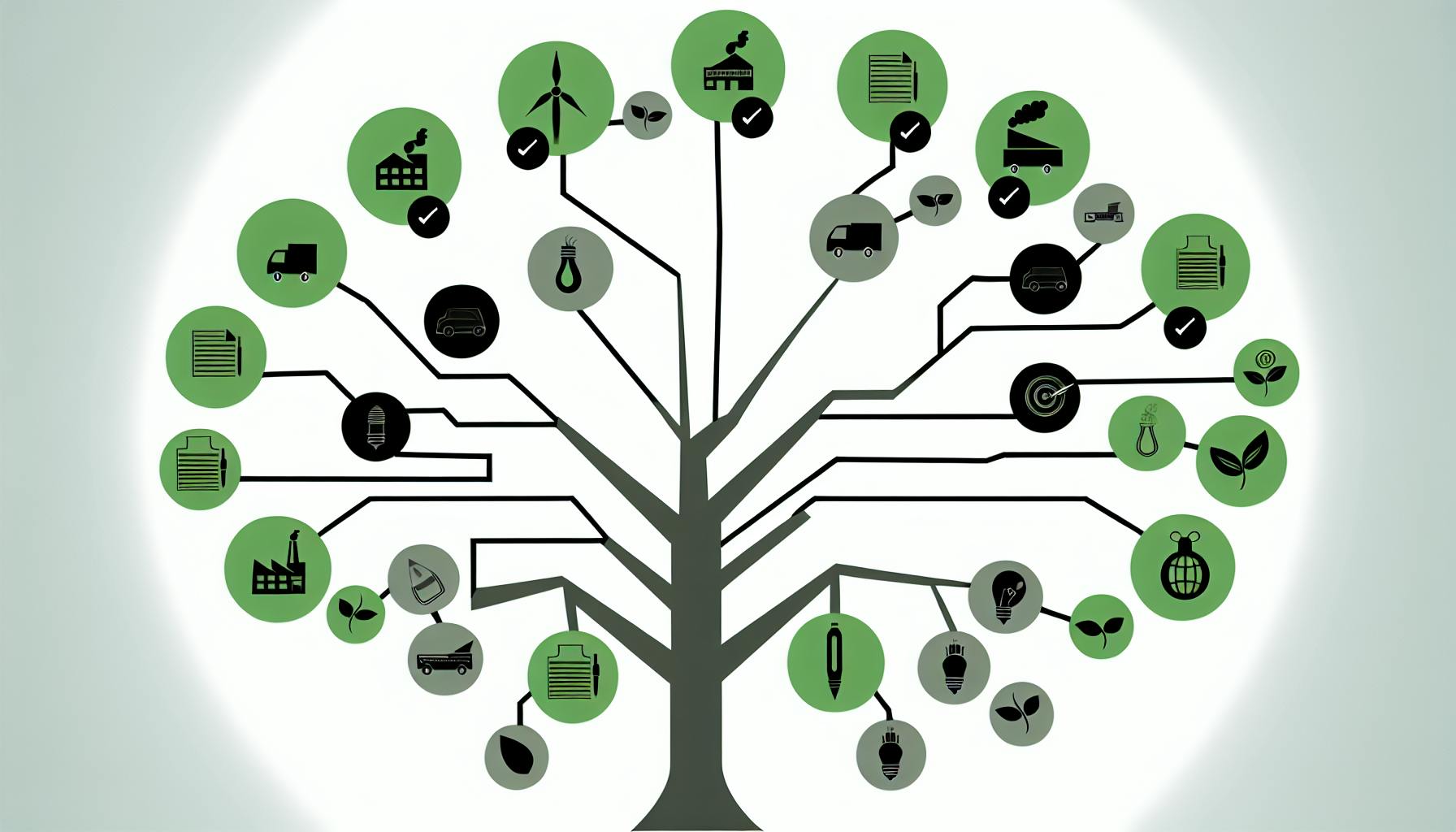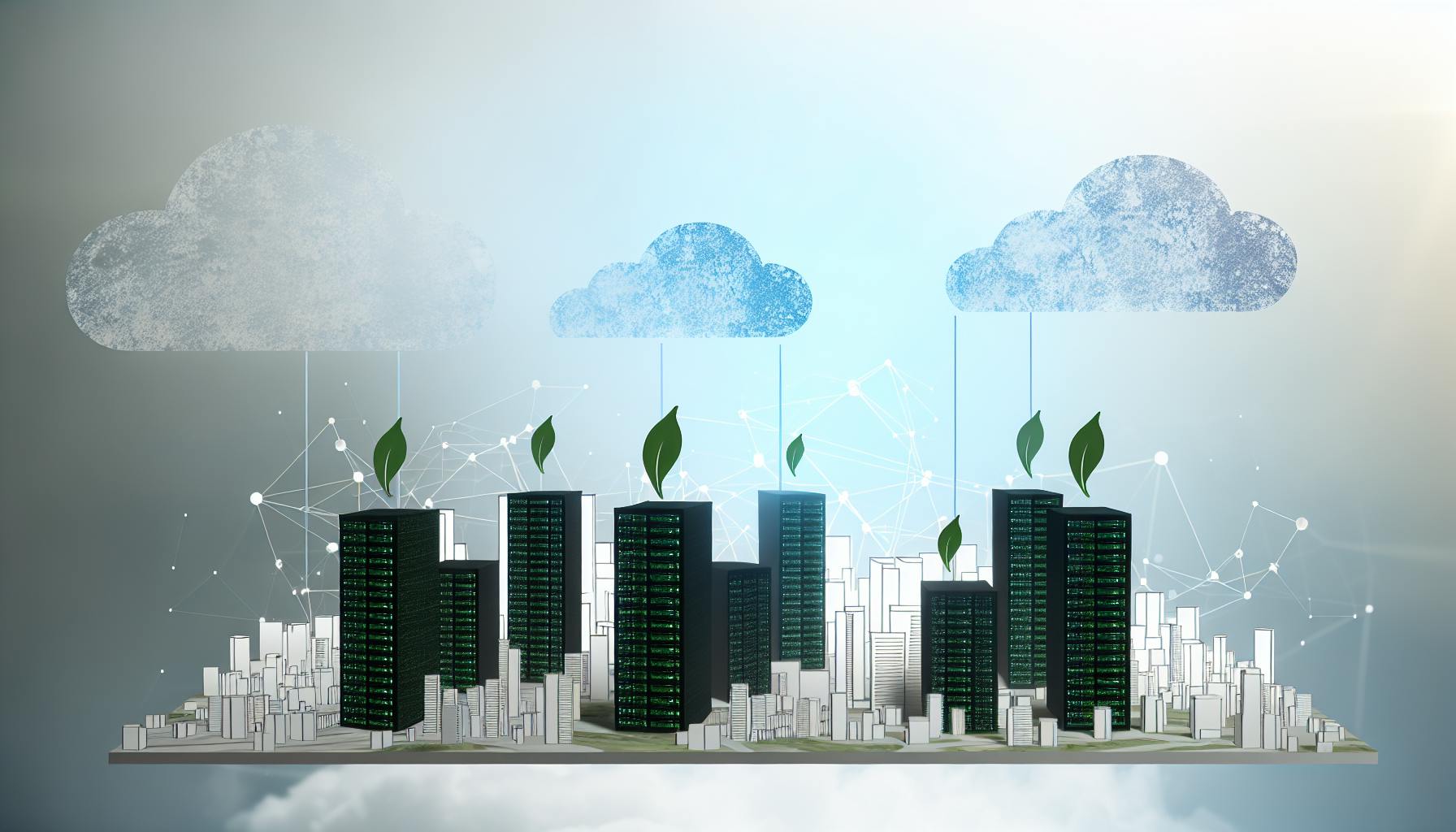Understanding carbon emissions can seem daunting for small and medium-sized enterprises (SMEs). With climate change accelerating, measuring and reducing your business's carbon footprint is no longer optional.
This guide breaks down the complex issue of scope 1, 2, and 3 emissions into clear, actionable advice for SMEs. You'll learn simple ways to calculate your carbon footprint across operations, supply chain, and product lifecycles.
With the right emissions reduction strategies tailored to your business, you can transform climate action into a core competitive advantage while contributing to a sustainable future.
Demystifying Carbon Emissions for SMEs
Carbon emissions are a critical issue that businesses of all sizes need to address. Small and medium-sized enterprises (SMEs) have an important role to play in mitigating climate change. Understanding your company's carbon footprint across Scopes 1, 2, and 3 is the vital first step.
The Imperative of Carbon Consciousness in Today's Business
With rising stakeholder expectations and tightening regulations around sustainability reporting, SMEs must make carbon emissions a priority. Developing a carbon reduction strategy now will reduce business risk and open up opportunities for sustainable growth. Focusing efforts based on scopes of emissions provides a simplified framework.
Breaking Down the Scopes of Carbon Emissions
The Greenhouse Gas (GHG) Protocol categorizes emissions into three groups:
-
Scope 1 - Direct emissions from owned or controlled sources like company vehicles and equipment. Knowing your Scope 1 emissions provides the baseline to build a management strategy.
-
Scope 2 - Indirect emissions from purchased electricity and heating. As an SME, these are typically easy to measure and reduce through energy efficiency and renewable energy procurement.
-
Scope 3 - All other indirect emissions across the value chain. While more complex, understanding scope 3 is key for SMEs to enable engagement with partners on decarbonization.
Why SMEs Must Measure and Mitigate Emissions
Though smaller in scale individually, SMEs have a collective carbon footprint requiring coordinated effort. Accurately measuring scopes of emissions allows targeted reduction strategies to be put in place. With stakeholders demanding sustainability improvements, quantifying and lowering emissions is both a reputational and cost-saving opportunity for SMEs. The scopes framework simplifies the process to make progress.
What are scope 1 and scope 2 and 3 emissions?
The Greenhouse Gas (GHG) Protocol defines scope 1, 2, and 3 emissions as different classifications of a company's carbon footprint. Understanding these scopes is key for businesses looking to measure, report on, and reduce their emissions.
Scope 1 Emissions
Scope 1 emissions are direct greenhouse gas emissions that come from sources owned or controlled by the company. Examples include:
- Emissions from fuel combustion in company facilities, vehicles, and equipment
- Fugitive emissions from refrigerants in AC units or industrial gases
- Emissions from chemical production in owned or controlled process equipment
Scope 2 Emissions
Scope 2 accounts for indirect GHG emissions from the generation of purchased electricity, steam, heating, or cooling consumed by the company. Although the company does not directly emit these greenhouse gases, it is responsible for the production of them through its energy use.
Scope 3 Emissions
Scope 3 emissions are all indirect emissions not covered in Scope 2 that occur in the company's value chain. This includes emissions from:
- Purchased goods and services
- Transportation and distribution
- Waste disposal
- Employee commuting
- Leased assets and franchises
- Investments
Understanding the differences between Scope 1, 2, and 3 emissions allows companies to identify the largest contributors to their carbon footprint. This enables them to set effective emissions reductions targets and engage stakeholders on sustainability efforts.
What are scope 3 carbon emissions?
Scope 3 emissions refer to indirect greenhouse gas emissions that occur in a company's value chain but are not directly controlled by the company. They include emissions from:
- Purchased goods and services
- Transportation and distribution
- Waste disposal
- Employee commuting
- Leased assets
- Investments
- Franchises
- Use of sold products
Scope 3 emissions are often the largest category of emissions for many companies, especially in service industries, accounting for on average 5.5 times as much as scope 1 and 2 emissions combined.
For small and medium enterprises (SMEs), calculating scope 3 emissions can be challenging due to complex supply chains and lack of emission data from suppliers. However, estimating scope 3 emissions helps companies identify risks and opportunities to reduce emissions through collaboration with value chain partners.
Key benefits of measuring scope 3 emissions for SMEs:
- Identify hotspots to prioritize emission reduction initiatives
- Engage suppliers in sustainability efforts
- Meet customer and investor demands for climate transparency
- Uncover cost savings through supply chain efficiency
With proper guidelines and tools, SMEs can develop quality scope 3 inventories tailored to their goals and resources. Though complex, scope 3 accounting enables impactful climate action across the full value chain.
What are scope 5 emissions?
I apologize, but there is no such thing as "scope 5" emissions based on the internationally recognized GHG Protocol methodology. The GHG Protocol defines three categories of emissions:
- Scope 1 - Direct emissions from owned or controlled sources
- Scope 2 - Indirect emissions from the generation of purchased energy
- Scope 3 - All indirect emissions (not included in scope 2) that occur in the value chain of the reporting company, including both upstream and downstream emissions
The number of scope categories stops at scope 3. While the terminology can seem complex at first, the GHG Protocol provides a robust and globally consistent framework for organizations to account for and report their greenhouse gas emissions. By accurately measuring scopes 1, 2, and 3 emissions, companies gain actionable insights to develop effective carbon reduction strategies on the path towards net-zero.
I hope this helps explain the purpose and definitions around the categorization of emissions. Please let me know if you need any clarification or have additional questions!
What are the 15 scope 3 categories?
The 15 scope 3 emissions categories help businesses measure and report indirect emissions from activities across their value chain according to the GHG Protocol Corporate Value Chain (Scope 3) Accounting and Reporting Standard. These categories encompass substantial indirect emissions outside a company's scope 1 and 2 that they can influence but do not directly control or own.
The 15 categories are:
- Category 1: Purchased goods and services
- Category 2: Capital goods
- Category 3: Fuel-and-energy-related activities
- Category 4: Upstream transportation and distribution
- Category 5: Waste generated in operations
- Category 6: Business travel
- Category 7: Employee commuting
- Category 8: Upstream leased assets
- Category 9: Downstream transportation and distribution
- Category 10: Processing of sold products
- Category 11: Use of sold products
- Category 12: End-of-life treatment of sold products
- Category 13: Downstream leased assets
- Category 14: Franchises
- Category 15: Investments
Understanding these categories allows companies to identify emission hotspots to address across their value chain. Tracking and reporting scope 3 emissions also enables businesses to engage stakeholders on sustainability efforts and identify opportunities for driving future emission reductions.
sbb-itb-919600f
Delineating Scope 1 Emissions: Direct Emissions from SME Operations
This section provides an overview of Scope 1 emissions and strategies for SMEs to measure and reduce their direct emissions footprint.
Identifying Common Scope 1 Emissions Examples for SMEs
Scope 1 covers direct greenhouse gas (GHG) emissions from sources owned or controlled by a company. For SMEs, typical examples include:
- Emissions from on-site fuel combustion for heating/cooling systems and generators
- Fugitive emissions from refrigeration and air conditioning equipment
- Transportation emissions from company-owned vehicles
As per the GHG Protocol, these emissions fall under Scope 1 as they stem from sources directly owned or operated by the SME.
Gathering Data for Scope 1 Emissions Inventory
To calculate Scope 1 emissions, SMEs need to collect activity data on fuel and energy usage:
- Fuel combustion: Collect details on fuel types, volumes consumed and emission factors
- Fugitive emissions: Record refrigerant recharges and leak inspection details
- Transportation: Log business mileage data for owned vehicles
Monitoring equipment can automate data collection. Manual recording in spreadsheets also works for smaller SMEs.
Conducting Reliable GHG Protocol Scope 1 Calculations
Once quality data is gathered, apply the GHG Protocol formula:
Emissions = Activity Data x Emission Factor
For example, annual emissions from a company boiler can be calculated by multiplying its natural gas usage (activity data) by the EPA emission factor for natural gas.
Emission factors are available from authoritative sources like EPA and IPCC guidelines.
Strategies for Minimizing Scope 1 Emissions
To reduce direct emissions, SMEs can:
- Switch heating fuel to lower carbon alternatives
- Improve building insulation and HVAC equipment efficiency
- Replace older vehicles with electric/hybrid models
- Adopt eco-driving practices to cut transportation emissions
Prioritizing these initiatives per the GHG Protocol will help shrink an SME’s Scope 1 carbon footprint.
Unpacking Scope 2 Emissions: Indirect Emissions from Energy
Scope 2 emissions refer to indirect greenhouse gas (GHG) emissions that occur from the generation of purchased electricity, steam, heating, or cooling. For many businesses, these emissions can form a major part of their carbon footprint.
Understanding how to calculate and report on Scope 2 emissions is key for organizations on the path to net-zero. This guide breaks down the essentials.
Scope 2 Emissions Examples: The Impact of Purchased Electricity and Heat
Purchased electricity makes up the bulk of most companies' Scope 2 footprint. For example, the emissions from powering office equipment, machinery, lighting, heating, and cooling systems all fall under Scope 2.
Some examples include:
- Emissions from the electricity used to power computers, servers, machinery, and appliances in an office
- Emissions from electricity or gas purchased to heat/cool office spaces and warehouses
- Emissions from electricity used in company-owned vehicles (e.g. forklifts)
As these examples show, understanding and measuring Scope 2 emissions enables companies to identify energy hotspots and opportunities to switch to renewable power sources.
Methodologies for How to Calculate Scope 2 Emissions
There are two primary methods for calculating Scope 2 emissions:
Location-Based Method: Calculates emissions based on average energy generation emission factors for the local grids that supply energy to the company's facilities.
Market-Based Method: Calculates emissions based on the actual sources of electricity that a company has purposefully chosen (or its lack of choice).
The Greenhouse Gas (GHG) Protocol recommends using the market-based method where possible, as this better reflects the emissions the company is directly responsible for.
Data Collection Best Practices for Scope 2 Emissions Accounting
To accurately measure Scope 2 emissions, businesses need access to extensive energy data, including:
- Monthly energy usage data (kWh) for all operations
- Details on energy sources, suppliers, energy mix info
- Records of owned renewable energy systems
- Emissions factors for relevant energy grids
Ongoing data collection processes should be implemented to streamline energy reporting. Smart meters, invoices, and other digitized records hugely simplify this.
Scope 1 and 2 Emissions: The Combined Reporting Approach
While separating emissions data has analytical advantages, most experts recommend combining Scope 1 and Scope 2 emissions reporting to provide a complete picture of a company's operational emissions impact.
Taken together, Scope 1+2 emissions reflect the emissions outputs directly occurring from a company's owned/controlled operations - providing a solid baseline carbon footprint to inform reduction strategies.
By understanding both their direct and energy indirect emissions, organizations can pinpoint not just the areas needing change, but also those already aligning with net-zero trajectories.
Exploring Scope 3 Emissions: The Value Chain Impact
Scope 3 emissions refer to all indirect emissions across a company's value chain, from purchased goods and services to transportation and distribution. For SMEs, calculating and reporting Scope 3 emissions can be complex. This section offers guidance on the key Scope 3 categories for SMEs and strategies to measure, report, and reduce value chain emissions.
A Primer on Scope 3 Emissions Categories
The GHG Protocol defines 15 categories of Scope 3 emissions. The most relevant for SMEs include:
- Purchased goods and services
- Transportation and distribution
- Business travel
- Waste generated in operations
- Use of sold products
Understanding emissions hotspots in these areas allows SMEs to prioritize reduction efforts.
How SMEs Can Engage with Scope 3 Emissions Categories
To calculate Scope 3 emissions, SMEs should:
- Identify their largest Scope 3 categories based on spend and operational data
- Work with suppliers to obtain emissions factors for key purchased products/services
- Utilize emissions calculators for business travel and waste
- Estimate emissions from transportation/distribution
While less precise than Scope 1 and 2 calculations, this method allows SMEs to approximate their value chain impacts.
Leveraging Partnerships to Address Upstream and Downstream Emissions
SMEs can collaborate with suppliers on green procurement policies, transport efficiency, and product lifecycle assessments. Engaging customers on sustainable usage and end-of-life for sold products also aids value chain decarbonization.
Setting Realistic Targets for Scope 3 Emissions Reduction
As Scope 3 calculations have higher uncertainty, SMEs should set flexible targets, such as:
- 5% reduction in emissions from purchased goods and services over 2 years
- 10% reduction in transport emissions per unit of product by 2025
Continuous refinement of Scope 3 data quality and target-setting allows for effective value chain engagement over time.
Reporting and Disclosure: Communicating Carbon Performance
This section provides guidance for SMEs on best practices for reporting and disclosing carbon emissions data to stakeholders. It emphasizes the importance of transparency and utilizing recognized frameworks.
The Essentials of Carbon Reporting Frameworks for SMEs
The key carbon reporting framework that SMEs should follow is the Greenhouse Gas (GHG) Protocol. Developed by the World Resources Institute and the World Business Council for Sustainable Development, the GHG Protocol delineates standards and guidance for measuring and reporting GHG emissions.
Within the GHG Protocol, emissions are categorized into three scopes:
- Scope 1 - Direct emissions from sources owned or controlled by the company. Examples include emissions from fuel combustion in company vehicles.
- Scope 2 - Indirect emissions from purchased electricity used by the company.
- Scope 3 - All other indirect emissions from activities of the company, but that occur from sources not owned or controlled by the company. Examples include business travel, waste disposal, etc.
For SMEs just starting the emissions accounting process, initially focusing on Scope 1 and 2 allows for greater control and accuracy. As programs mature, expanding to capture more Scope 3 emissions provides a more complete carbon footprint.
Other key frameworks SMEs should be aware of:
- ISO 14064 Standards for GHG Reporting
- CDP Reporting Platform
- The Climate Registry
- Global Reporting Initiative (GRI) Standards
Familiarity with these reporting frameworks helps SMEs speak the same language as stakeholders and partners regarding carbon emissions disclosures.
Best Practices for Transparent Emissions Disclosure
When disclosing emissions, SMEs should:
- Publish a public-facing sustainability report at least annually covering Scopes 1, 2, and material Scope 3 emissions
- Clearly state methodologies and standards used to calculate emissions
- Allow data to be accessible to stakeholders instead of publishing solely aggregate data
- Have emissions inventories and reports independently verified by a credible third-party at least every other year
- Track and report various emissions metrics beyond just total footprint, such as intensity ratios
- Commit to consistently improving the quality and accuracy of measurements over time by refining methodologies
Following these best practices allows SMEs to build trust and transparency with stakeholders through emissions disclosures.
Managing and Utilizing Carbon Offsets for Residual Emissions
As SMEs work to reduce emissions, carbon offsets can mitigate residual hard-to-abate emissions in the short term. Offsets apply the concept that GHG reductions in one area, project, or activity can compensate for emissions occurring elsewhere. Offsets are an interim solution for neutralizing emissions an SME cannot immediately address through direct reduction actions and technology changes.
When exploring offsets, SMEs should prioritize high-quality projects with verifiable impacts backed by certifications like Verified Carbon Standard (VCS) and The Gold Standard. Offsets enable carbon neutral or net zero goals but should not replace internal efforts to cut emissions. Long-term strategies should still stress decarbonization through energy efficiency, renewable energy, circular economy solutions and other emissions reduction pathways.
Embedding Emissions Strategy within SME Operations
Integrating sustainability into business operations is key for SMEs looking to reduce their carbon footprint. By aligning emissions goals with wider business objectives, SMEs can build a company culture focused on achieving net-zero.
Aligning Carbon Management with Business Objectives
-
Set emissions reduction targets that align with business growth plans. Focus on efficiency improvements that also cut costs.
-
Appoint dedicated sustainability leads to coordinate efforts across departments. Make sustainability someone's responsibility.
-
Analyze lifecycle emissions across operations and supply chain. Identify priority areas for reduction initiatives.
-
Review business processes to spot sustainability opportunities. Can systems be optimized to save energy?
Cultivating a Culture of Sustainability in the Workplace
-
Lead by example. Management must fully commit to sustainability initiatives for employees to follow.
-
Incentivize staff to share ideas and innovations for reducing the company's carbon footprint. Recognize sustainability champions.
-
Keep employees updated on emissions performance and reduction initiatives. Share progress and foster accountability.
-
Make sustainability engaging. Infuse camaraderie into environmental initiatives through friendly office competitions.
Innovative Solutions for Continuous Emissions Improvement
-
Leverage technology like emissions management software to automatically track and analyze carbon footprint over time.
-
Explore efficiency upgrades to heating/cooling systems, equipment, appliances and lighting to persistently shrink energy consumption.
-
Switch to renewable energy providers. On-site solar generation can also help shrink Scope 2 grid-sourced emissions.
-
Engage with suppliers on sustainability commitments. Encourage demonstration of emissions reduction efforts.
Conclusion: Synthesizing Emissions Strategies for Future Growth
Reviewing Key Points and Best Practices
Measuring and managing carbon emissions can seem daunting for small and medium-sized enterprises (SMEs), but breaking down the process into Scope 1, 2, and 3 categories as outlined by the Greenhouse Gas (GHG) Protocol creates a more structured approach. Getting a handle on emissions data allows SMEs to benchmark, set reduction targets, track progress, engage stakeholders, and make strategic decisions to lower environmental impacts.
Best practices going forward include:
- Calculate your carbon footprint annually using accurate activity data and emission factors
- Prioritize the largest sources of emissions within your operations and value chain
- Set science-based targets to reduce your emissions on a trajectory towards net-zero
- Offset residual emissions you cannot eliminate by supporting certified carbon removal projects
- Disclose your emissions data and reduction strategies to investors, customers and employees
Following structured carbon accounting methodologies builds essential capabilities that enable SMEs to cost-effectively decarbonize while gaining a competitive edge.
Looking Ahead: Sustainability as Competitive Advantage
As societal and investor pressure grows for urgent climate action, an increasing number of SMEs will be seeking tools and strategies to measure, understand, and reduce their carbon impacts. Early movers that proactively improve their sustainability performance can reap multiple bottom line benefits, from cost savings and risk mitigation to new market opportunities, investor capital, and talent acquisition.
Forward-looking SMEs should view sustainability not just as an obligation, but as a core component of business strategy that delivers resiliency and future value creation. Wise investment in emissions measurement and management today pays dividends in capturing the growth opportunities of tomorrow's net-zero carbon economy.



.png)


